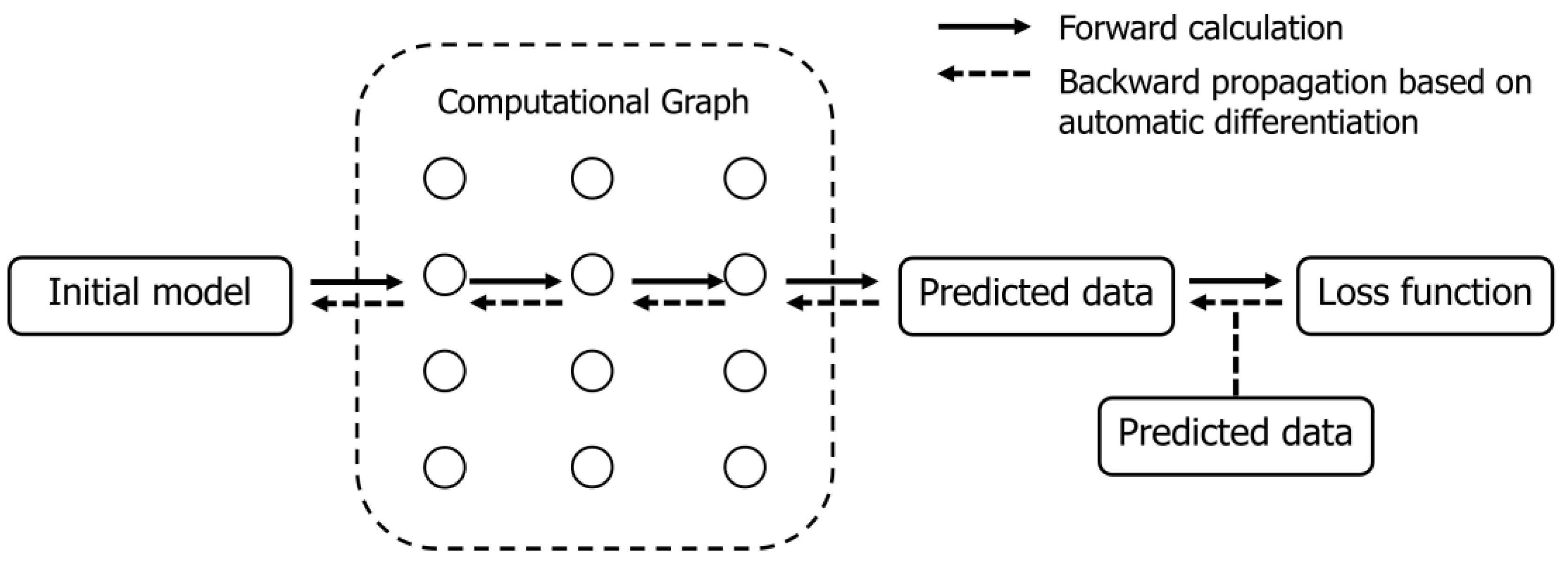CO2 Storage Monitoring via Time-Lapse Full Waveform Inversion with Automatic Differentiation
Abstract
1. Introduction
2. Methods
2.1. Time-Lapse Full Waveform Inverison
2.2. Automatic Differentiation
3. Results
3.1. Frio-II CO2 Storage Model
Site Background
4. Conclusions
Author Contributions
Funding
Data Availability Statement
Conflicts of Interest
References
- Yang, J.; He, X.; Chen, H. Crosswell Frequency-Domain Reverse Time Migration Imaging with Wavefield Decomposition. J. Geophys. Eng. 2023, 20, 1279–1290. [Google Scholar] [CrossRef]
- Zhu, T.; Ajo-Franklin, J.; Daley, T.M.; Marone, C. Dynamics of Geologic CO2 Storage and Plume Motion Revealed by Seismic Coda Waves. Proc. Natl. Acad. Sci. USA 2019, 116, 2464–2469. [Google Scholar] [CrossRef] [PubMed]
- Kolkman-Quinn, B.; Lawton, D.C.; Macquet, M. CO2 Leak Detection Threshold Using Vertical Seismic Profiles. Int. J. Greenh. Gas Control 2023, 123, 103839. [Google Scholar] [CrossRef]
- Glubokovskikh, S.; Pevzner, R.; Gunning, J.; Dance, T.; Shulakova, V.; Popik, D.; Popik, S.; Bagheri, M.; Gurevich, B. How Well Can Time-Lapse Seismic Characterize a Small CO2 Leakage into a Saline Aquifer: CO2CRC Otway 2C Experiment (Victoria, Australia). Int. J. Greenh. Gas Control 2020, 92, 102854. [Google Scholar] [CrossRef]
- Li, D.; Xu, K.; Harris, J.M.; Darve, E. Coupled Time-Lapse Full Waveform Inversion for Subsurface Flow Problems Using Intrusive Automatic Differentiation. arXiv 2020, arXiv:1912.07552. Available online: http://arxiv.org/abs/1912.07552 (accessed on 25 November 2023). [CrossRef]
- Ajo-Franklin, J.B.; Peterson, J.; Doetsch, J.; Daley, T.M. High-Resolution Characterization of a CO2 Plume Using Crosswell Seismic Tomography: Cranfield, MS, USA. Int. J. Greenh. Gas Control 2013, 18, 497–509. [Google Scholar] [CrossRef]
- Arts, R.; Eiken, O.; Chadwick, A.; Zweigel, P.; Van Der Meer, L.; Zinszner, B. Monitoring of CO2 Injected at Sleipner Using Time-Lapse Seismic Data. Energy 2004, 29, 1383–1392. [Google Scholar] [CrossRef]
- Daley, T.M.; Myer, L.R.; Peterson, J.E.; Majer, E.L.; Hoversten, G.M. Time-Lapse Crosswell Seismic and VSP Monitoring of Injected CO2 in a Brine Aquifer. Environ. Geol. 2008, 54, 1657–1665. [Google Scholar] [CrossRef]
- Lazaratos, S.K.; Marion, B.P. Crosswell Seismic Imaging of Reservoir Changes Caused by CO2 Injection. Lead. Edge 1997, 16, 1300–1308. [Google Scholar] [CrossRef]
- Huang, C.; Zhu, T. Towards Real-Time Monitoring: Data Assimilated Time-Lapse Full Waveform Inversion for Seismic Velocity and Uncertainty Estimation. Geophys. J. Int. 2020, 223, 811–824. [Google Scholar] [CrossRef]
- Huang, C.; Zhu, T. Time-Lapse Full Waveform Inversion plus Extended Kalman Filter for High-Resolution Seismic Models and Uncertainty Estimation. In SEG Technical Program Expanded Abstracts 2019; Society of Exploration Geophysicists: San Antonio, TX, USA, 2019; pp. 5239–5244. [Google Scholar] [CrossRef]
- Zhu, W.; Xu, K.; Darve, E.; Beroza, G.C. A General Approach to Seismic Inversion with Automatic Differentiation. Comput. Geosci. 2021, 151, 104751. [Google Scholar] [CrossRef]
- Song, C.; Wang, Y.; Richardson, A.; Liu, C. Weighted Envelope Correlation-Based Waveform Inversion Using Automatic Differentiation. IEEE Trans. Geosci. Remote Sens. 2023, 61, 1–11. [Google Scholar] [CrossRef]
- Hu, Q.; Grana, D.; Innanen, K.A. Feasibility of Seismic Time-Lapse Monitoring of CO2 with Rock Physics Parametrized Full Waveform Inversion. Geophys. J. Int. 2022, 233, 402–419. [Google Scholar] [CrossRef]
- Zhang, Z.; Huang, L. Double-Difference Elastic-Waveform Inversion with Prior Information for Time-Lapse Monitoring. Geophysics 2013, 78, R259–R273. [Google Scholar] [CrossRef]
- Yang, D.; Fehler, M.; Malcolm, A.; Liu, F.; Morton, S. Double-Difference Waveform Inversion of 4D Ocean Bottom Cable Data: Application to Valhall, North Sea. In SEG Technical Program Expanded Abstracts 2013; Society of Exploration Geophysicists: San Antonio, TX, USA, 2013; pp. 4966–4970. [Google Scholar] [CrossRef]
- Liu, Y.; Tang, J.; Tang, Z.; Sun, C. Robust Full-Waveform Inversion Based on Automatic Differentiation and Differentiable Dynamic Time Warping. J. Geophys. Eng. 2023, 20, 549–564. [Google Scholar] [CrossRef]
- Daley, T.M.; Solbau, R.D.; Ajo-Franklin, J.B.; Benson, S.M. Continuous Active-Source Seismic Monitoring of CO2 Injection in a Brine Aquifer. Geophysics 2007, 72, A57–A61. [Google Scholar] [CrossRef]
- Daley, T.M.; Ajo-Franklin, J.B.; Doughty, C. Constraining the Reservoir Model of an Injected CO2 Plume with Crosswell CASSM at the Frio-II Brine Pilot. Int. J. Greenh. Gas Control 2011, 5, 1022–1030. [Google Scholar] [CrossRef]
- Yang, J.; He, X.; Chen, H. Processing the Artificial Edge-Effects for Finite-Difference Frequency-Domain in Viscoelastic Anisotropic Formations. Appl. Sci. 2022, 12, 4719. [Google Scholar] [CrossRef]






Disclaimer/Publisher’s Note: The statements, opinions and data contained in all publications are solely those of the individual author(s) and contributor(s) and not of MDPI and/or the editor(s). MDPI and/or the editor(s) disclaim responsibility for any injury to people or property resulting from any ideas, methods, instructions or products referred to in the content. |
© 2024 by the authors. Licensee MDPI, Basel, Switzerland. This article is an open access article distributed under the terms and conditions of the Creative Commons Attribution (CC BY) license (https://creativecommons.org/licenses/by/4.0/).
Share and Cite
Yang, J.; Yu, P.; Wang, S.; Sun, Z. CO2 Storage Monitoring via Time-Lapse Full Waveform Inversion with Automatic Differentiation. Nanomaterials 2024, 14, 138. https://doi.org/10.3390/nano14020138
Yang J, Yu P, Wang S, Sun Z. CO2 Storage Monitoring via Time-Lapse Full Waveform Inversion with Automatic Differentiation. Nanomaterials. 2024; 14(2):138. https://doi.org/10.3390/nano14020138
Chicago/Turabian StyleYang, Jixin, Pengliang Yu, Suran Wang, and Zheng Sun. 2024. "CO2 Storage Monitoring via Time-Lapse Full Waveform Inversion with Automatic Differentiation" Nanomaterials 14, no. 2: 138. https://doi.org/10.3390/nano14020138
APA StyleYang, J., Yu, P., Wang, S., & Sun, Z. (2024). CO2 Storage Monitoring via Time-Lapse Full Waveform Inversion with Automatic Differentiation. Nanomaterials, 14(2), 138. https://doi.org/10.3390/nano14020138





